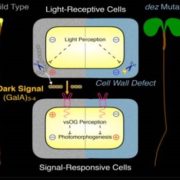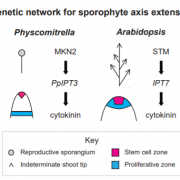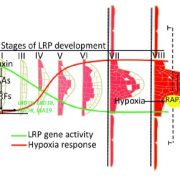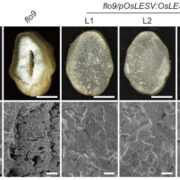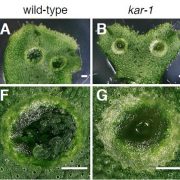Boundary formation through direct threshold-based readout of mobile small RNA gradients
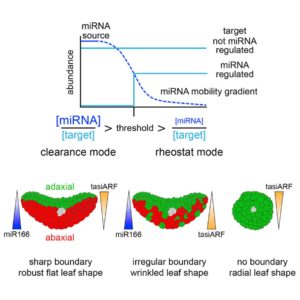 How does a flat leaf form? Previous studies have indicated that the formation of a flattened blade depends upon a boundary layer between the upper and lower cell layers, and that mobile small RNAs contribute to this boundary, but how this occurs is not fully resolved. For example, although the small RNA tasiRNA is present in a diffused gradient pattern, its targets (ARF transcription factors) accumulate in an “on or off” binary pattern. Skopelitis et al. approach this question by experimentally altering small RNA distribution patterns, and find that there is a sharp threshold response directly attributable to the ratio between a small RNA and its target, largely independent of the cell layer in which this threshold lies. Similar results were seen using artificial miRNA and targets (miRGFP silencing GFP). These data argue against a pre-pattern and against the boundary requiring feedback from downstream factors, and indicate that “binary readouts are an intrinsic property of small RNA gradients.” (Summary by Mary Williams) Devel. Cell 10.1016/j.devcel.2017.10.003
How does a flat leaf form? Previous studies have indicated that the formation of a flattened blade depends upon a boundary layer between the upper and lower cell layers, and that mobile small RNAs contribute to this boundary, but how this occurs is not fully resolved. For example, although the small RNA tasiRNA is present in a diffused gradient pattern, its targets (ARF transcription factors) accumulate in an “on or off” binary pattern. Skopelitis et al. approach this question by experimentally altering small RNA distribution patterns, and find that there is a sharp threshold response directly attributable to the ratio between a small RNA and its target, largely independent of the cell layer in which this threshold lies. Similar results were seen using artificial miRNA and targets (miRGFP silencing GFP). These data argue against a pre-pattern and against the boundary requiring feedback from downstream factors, and indicate that “binary readouts are an intrinsic property of small RNA gradients.” (Summary by Mary Williams) Devel. Cell 10.1016/j.devcel.2017.10.003


